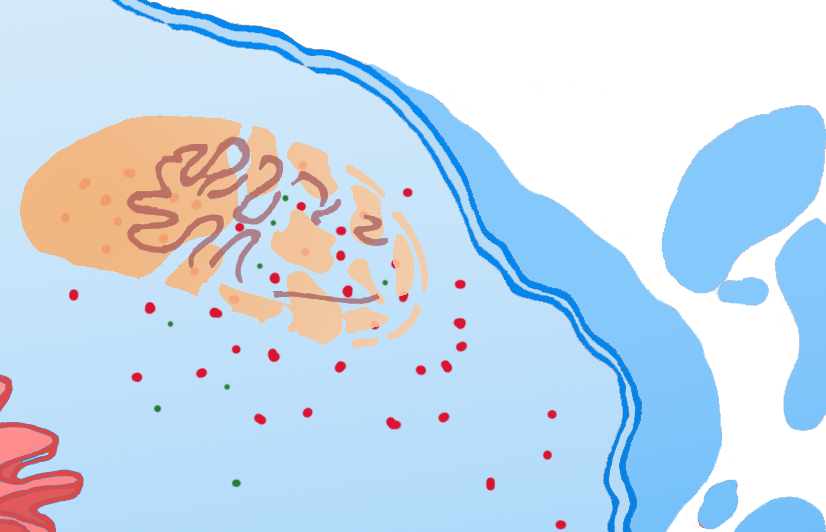Team:Warsaw/Project/cytoplasm
From 2009.igem.org
Contents |
Cytoplasmatic module
When bacteria get into cytoplasm we we can employ many ways of further accidents. During our brainstorms we have thought about at least two of them. First idea is that bacteria can secrete some proapoptotic proteins what will lead to death of host cell (especially interesting if host cell is tumor). The second, which came from our supervisor, prof. Stępień, is to enable our BacInVader to conjugate with mammalian mitochondria. Although both ideas are interesting we decided to concentrate on the first one - induction of apoptosis via secretion of proapoptotic proteins. More detailed description of the idea of bateria conjugation with mitochondira can be found in the Future plans part of this website.
Theoretical basis
Bacterial systems of protein secretion
Free living bacteria make use of a diverse spectrum of transport and secretion systems. In gram negative bacteria type I secretion systems are very common e.g. the well characterized hemolysin secretion system. Hemolysin is responsible for the pathogenicity of some E. coli strains. Obtaining a fusion of a protein of interest with the hemolysin C-terminus results in the secretion of the protein into the growth medium[6] The same method can be used to secret bacterial proteins into the cytoplasm. This has already found its application in the new generation of vaccines[5].
Induction of apoptosis
Mitochondrial outer membrane permabilization MOMP is one of the main programmed cell death mechanisms. The process is regulated by a PTPc complex and a Bcl2 family proteins [17]. Many types of cancer involve disruption of this process therefore inducing MOMP in the tumour cells is regarded as a potential therapeutic solution. MOMP-inducing factors include the p53 protein, which is mutated in almost half of the cancer cases. By acting as a transcription regulator in the nucleus, p53 arrests the cell cycle and induces apoptosis [18]. In the cytoplasm p53 interacts with mitochondrial membrane and can enter the mitochondrion. It has been proven that these processes induce apoptosis and does not influence the cell cycle. In the mitochondrion p53 is an effector protein that activates soluble (cytochrom c, Smac) and insoluble (AIF, EndoG) apoptototic factors. Moreover interaction of p53 and Bax protein in vitro leads to permabilisation of a lipid bilayer analogous to mitochondrial membrane. [12] Because p53 is inactive in tumour cells many research groups focused on designing gene therapies based on p53 gene delivery. Most frequently adenoviruses and eukaryotic plasmids are used. The results confir increased effectiveness of chemotherapeutic drugs following introduction of p53 gene copy into the cell [4]. It has been shown that p53 with the mitochondrial leader sequence alone is sufficient to induce apoptosis in mammalian cells. Fusion protein Lp53, with mitochondrial leader sequence from ornithine transcarbamylase was used. In terms of apoptosis induction fusion protein was almost as effective as standard p53. Previous research did not include the delivery of p53 into tumour cells by bacterial vectors. Our project proposes a method to induce apoptosis without arresting the cell cycle. Cell cycle arrest decreases the sensitivity of cancer cells to chemotherapeutic agents, because they can affect only proliferating cells [14]. Other proapoptotic protein is bax, cytoplasmatic protein, which is shifted to organelles, mainly mitochondria, upon induction of apoptosis. Bax is forming channels through which cytochrome c is realased to cytoplasm, leading directly to apoptosis.
Details
The cytoplasmic operon.

Fig 4. Overview of endosomal detection operon. It is composed of YFP – Yellow Fluorescent Protein, tetR – repressor of a tetracycline resistance operon, cro box regulatory sequence from λ phage and genes specific for a desired function of bacterial strain. In this case p53 – an apoptosis inducer.
Cytoplasmic operon, like the invasion operon, is a bistable switch. The regulatory elements are: a synthetic promoter inhibited by TetR, promoter inhibited by araC, the araC protein (inactivated by L-arabinose) and the TetR protein (repressor of the tetracycline resistance gene inactivated by tetracycline). [18] This switch controls genes expressed in the cytoplasm. Cro box confines the gene expression to the cytoplasm only. The cro protein bound to it stops the transcription while the endosome detection operon is expressed. The yellow florescence protein is expressed to allow for the detection of the cytoplasmic operon activity. The set of genes in the cytoplasmic operon depends on the desired function of a specific bacterial strain. In the case of an antitumor therapy this could be the p53 protein with mitochondrial leader sequence or the Bax protein. In the strain capable of conjugation with mitochondria cytoplasmic operon will control genes responsible for the conjugation process.
Secretion of p53 into the cytoplasm
To efficiently transport p53 to the eukaryotic cells the endogenic E. coli secretion system responsible for secretion of hemolysin by uropathogenic strains will be used. It is composed of three transport proteins HlyB, HlyD and TolC [10]. TolC is present in the genome of the lab strain derived from K12 strain. To ensure efficient secretion hlyB and hlyD have to be introduced into the genome and proapoptotic protein has to be fused with 60 amino acid long C-terminal sequence of hemolysin. [5].
Directing bacterial proteins to mammalian mitochondria.
One of the nescessary objectives is to direct a fraction of secreted proteins into the mitochondrion. This will be achieved by fusing the mitochondrial leader sequence from human protein Cox1 to the N-terminus of p53. It has been shown that the 40 amino acids long N-terminal sequence is enough for effective transport of Cox1 across the mitochondrial membrane. First the efficiency of the process will be assessed by detection of Red Fluorescent Protein with confocal microscopy. The red fluorescence should be visible in the mitochondria of the cells invaded by bacteria expressing RFP fused with the mitochondrial leader sequence. Then the ability to induce apoptosis by mitochondrially directed p53 will be investigated. Apoptosis induction will be confirmed by flow cytometry [8]. In addition we will use confocal microscopy to monitor the process. In both cases cells will be stained with propidium iodide and annexin V.
 "
"
